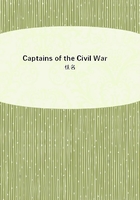
第10章 THE CLASH: 1861(9)
Such was the central scene of action, where the first great battle of the war was fought. The Union forces were based on the Potomac from Washington to Harper's Ferry. The Confederates faced them from Bull Run to Winchester, which points were nearly sixty miles apart by road and rail. The Union forces were fifty thousand strong, the Confederate thirty-three thousand. The Union problem was how to keep "Joe" Johnston in the Winchester position by threatening or actually making an invasion of the Shenandoah Valley with Patterson's superior force, while McDowell's superior force attacked or turned Beauregard's position at Bull Run. The Confederate problem was how to give Patterson the slip and reach Bull Run in time to meet McDowell with an equal force. The Confederates had the advantage of interior lines both here and in the semicircle as a whole, though the Union forces enjoyed in general much better means of transportation. The Confederates enjoyed better control from government headquarters, where the Cabinet mostly had the sense to trust in Lee. Scott, on the other hand, was tied down by orders to defend Washington by purely defensive means as well as by the "on to Richmond" march.
Patterson was therefore obliged to watch the Federal back door at Harper's Ferry as well as the Confederate side doors up the Shenandoah : an impossible task, on exterior lines, with the kind of force he had. The civilian chiefs at Washington did not see that the best of all defense was to destroy the enemy's means of destroying THEM, and that his greatest force of fighting MEN, not any particular PLACE, should always be their main objective.
On the fourteenth of June Johnston had destroyed everything useful to the enemy at Harper's Ferry and retired to Winchester.
On the twentieth Jackson's brigade marched on Martinsburg to destroy the workshops of the Baltimore and Ohio Railway and to support the three hundred troopers under J. E. B. Stuart, who was so soon to be the greatest of cavalry commanders on the Confederate side. Unknown at twenty-nine, killed at thirty-one, "Jeb" Stuart was a Virginian ex-officer of United States Dragoons, trained in frontier fighting, and the perfect type of what a cavalry commander should be: tall, handsome, splendidly supple and strong, hawk-eyed and lion-hearted, quick, bold, determined, and inspiring, yet always full of knowledge and precaution too; indefatigable at all times, and so persistent in carrying out a plan that the enemy could no more shake him off than they could escape their shadows.
On the second of July the first brush took place at Falling Waters, five miles south of the Potomac, where Jackson came into touch with Patterson's advanced guard. As Jackson withdrew his handful of Virginian infantry the Federal cavalry came clattering down the turnpike and were met by a single shot from a Confederate gun that smashed the head of their column and sent the others flying. Meanwhile Stuart, who had been reconnoitering, came upon a company of Federal infantry resting in a field.
Galloping among them suddenly he shouted, "Throw down your arms or you are all dead men!" Whereupon they all threw down their arms; and his troopers led them off. Patterson, badly served by his very raw staff, reported Jackson's little vanguard as being precisely ten times stronger than it was. He pushed out cautiously to right and left; and when he tried to engage again he found that Jackson had withdrawn. Falling Waters was microscopically small as a fight. But it served to raise Confederate morale and depress the Federals correspondingly.
Patterson occupied Martinsburg,while Johnston, drawn up in line of battle, awaited his further advance four days before retiring.
Then, with his fourteen thousand, Patterson advanced again, stood irresolute under distracting orders from the Government in Washington, and finally went to Charlestown on the seventeenth of July--almost back to Harper's Ferry. Johnston, with his eleven thousand, now stood fast at Winchester, fifteen miles southwest, while Stuart, like a living screen, moved to and fro between them.
Meanwhile McDowell's thirty-six thousand had marched past the President with bands playing and colors flying amid a scene of great enthusiasm. The press campaign was at its height; so was the speechifying; and ninety-nine people out of. every hundred thought Beauregard's twenty-two thousand at Bull Run would be defeated in a way that would be sure to make the South give in.
McDowell had between two and three thousand regulars: viz., seven troops of cavalry, nine batteries of artillery, eight companies of infantry, and a little battalion of marines. Then there was the immense paper army voted on the Glorious Fourth. And here, for the general public to admire, was a collection of armed and uniformed men that members of Congress and writers in the press united in calling one of the best armies the world had ever seen.
Moreover, the publicity campaign was kept up unflaggingly till the very clash of arms began. Reporters marched along and sent off reams of copy. Congressmen, and even ladies, graced the occasion in every way they could. "The various regiments were brilliantly uniformed according to the aesthetic taste of peace,"wrote General Fry, then an officer on McDowell's staff, and "during the nineteenth and twentieth the bivouacs at Centreville, almost within cannon range of the enemy, were thronged with visitors, official and unofficial, who came in carriages from Washington, were under no military restraint, and passed to and fro among the troops as they pleased, giving the scene the appearance of a monster military picnic."Had McDowell been able to attack on either of these two days he must have won. But previous Governments had never given the army the means of making proper surveys; so here, within a day's march of the Federal capital, the maps were worthless for military use.